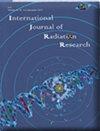Radioprotective effect of hesperidin against ovarian toxicity induced by Ionizing radiation through inhibiting oxidative stress in mice
IF 0.4
4区 医学
Q4 RADIOLOGY, NUCLEAR MEDICINE & MEDICAL IMAGING
引用次数: 1
Abstract
Background : Radiotherapy enhances the risk of ovarian injury induced by oxidative stress in the female patients. Hesperidin, as a natural compound has various biological properties included anti - tumoral, antioxidant, and anti - inflammatory activities. This research evaluated the effects of hesperidin on ovarian damage induced by IR. Materials and Methods : Twenty - eight female mice distributed to four groups randomly: Control, Hesperidin (100mg/kg), ionizing radiated (IR) (3.2 Gy), and ionizing radiated + hesperidin groups (3.2Gy + 100mg/kg). Hesperidin was administrated orally for 7 successive days. Animals were exposed to total body irradiation on the 8th day of study. Biochemical, hormonal (estrogen and progesterone), and histopathological assessments did on day 12. Results : IR group demonstrated necrosis, apoptosis, and atresia in ovaries, decreased estrogen and progesterone and increased oxidative stress. While Hesperidin pre - treatment improved histological features, recovered the number of follicles in ovaries of the irradiated mice. In addition, the Hesperidin increased estrogen and progesterone and decreased oxidative stress (malondialdehyde, Ferric Reducing Antioxidant Power, and catalase). Conclusion : Data of this research indicate that hesperidin is may be useful in female patients with pelvic cancer during radiotherapy for their ovarian conservation.橙皮苷通过抑制氧化应激对小鼠电离辐射卵巢毒性的辐射防护作用
背景:放射治疗可增加女性氧化应激所致卵巢损伤的风险。橙皮苷作为一种天然化合物,具有抗肿瘤、抗氧化、抗炎等多种生物学特性。本研究评价橙皮苷对IR致卵巢损伤的影响。材料与方法:雌性小鼠28只,随机分为4组:对照组、橙皮苷组(100mg/kg)、电离辐射组(3.2Gy)和电离辐射+橙皮苷组(3.2Gy + 100mg/kg)。连续7天口服橙皮苷。动物在研究第8天接受全身照射。第12天进行生化、激素(雌激素和黄体酮)和组织病理学评估。结果:IR组卵巢出现坏死、凋亡、闭锁,雌激素、孕激素水平下降,氧化应激升高。橙皮苷预处理改善了小鼠卵巢的组织学特征,恢复了卵巢卵泡的数量。此外,橙皮苷增加雌激素和黄体酮,降低氧化应激(丙二醛、铁还原抗氧化能力和过氧化氢酶)。结论:橙皮苷对盆腔癌女性放疗患者的卵巢保护有一定的作用。
本文章由计算机程序翻译,如有差异,请以英文原文为准。
求助全文
约1分钟内获得全文
求助全文
来源期刊

International Journal of Radiation Research
RADIOLOGY, NUCLEAR MEDICINE & MEDICAL IMAGING-
CiteScore
1.10
自引率
33.30%
发文量
42
期刊介绍:
International Journal of Radiation Research (IJRR) publishes original scientific research and clinical investigations related to radiation oncology, radiation biology, and Medical and health physics. The clinical studies submitted for publication include experimental studies of combined modality treatment, especially chemoradiotherapy approaches, and relevant innovations in hyperthermia, brachytherapy, high LET irradiation, nuclear medicine, dosimetry, tumor imaging, radiation treatment planning, radiosensitizers, and radioprotectors. All manuscripts must pass stringent peer-review and only papers that are rated of high scientific quality are accepted.
 求助内容:
求助内容: 应助结果提醒方式:
应助结果提醒方式:


